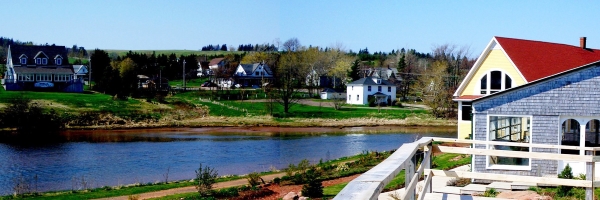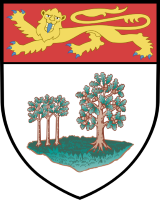






Use the links above to navigate this minisite. Click the logo in the upper-left to go back to the main homepage of KortJackson.org.
Welcome to coverage of the 2019 PEI Legislative Assembly election, provided by yours truly at KortJackson.org!
How did we get to here? (A timeline)
In 2015, Premier Robert Ghiz decided to call time on his career in politics, stepping down upon the selection of a new leader for the Prince Edward Island (PEI) Liberal Party (and as the Liberals or "Grits" held a majority, a new premier as well). Utimately, H. Wade MacLauchlan was selected as the new leader and became Premier. A short time later, voters went to the polls, and although the Grits saw their majority narrow slightly, Wade MacLauchlan earned a term in his own right, and the Liberals third straight win in PEI.
Initially, the Grits enjoyed a stupendous polling advantage, at one point racking up a lead of 69-17 against the Progressive Conservatives early in their third term. Historically, voters tend to give governments three terms (12 years) before giving the incumbents the boot and starting anew (1978 and 1986 provided the last two abberations: In 1978 the Grits narrowly got a fourth term, only to go to the polls the next year and be defeated, 1986 saw the PC government defeated after just two terms). It was appearing that a rare change of form was likely to occur, and MacLaughlan's Liberals were on track for that very rare fourth term.
But as 2018 and 2019 rolled on, the Liberal advantage vanished. The Green Party entered the provincial legislature in 2015 with the election of Dr. Peter Bevan-Baker and gained another seat in a by-election later in the term. Islanders became fascinated, then approving with Dr. Bevan-Baker's refreshing style of speaking and Green support soared. The PC's struggled with leadership challenges before settling on Peter King, and their numbers have rebounded slightly as well. Although an election wasn't due for a few more months, Premier MacLauchlan determined that the time was now for elections, hoping the narrow but changing leads in the polls flip back to the Grits, just perhaps one more time. All this will culminate in a election on April 23, in which voters will select 27 MLA's as well as a potentially new election system for the Island.
So, how does elections and government work in Canada? (and specifically Prince Edward Island)
Elections in Canada are done by first past the post voting. In essence, whomever gets the most votes in a riding (constituency), that person is deemed elected. The federal House of Commons (the Canadian Senate is appointed) and each of the provincial and territory legislatures follow the First Past the Post system. In addition, with the exception of Northwest Territories and Nunavut (non-partisan consensus governments), each province (plus Canada's House of Commons and the territory of Yukon) each have parties that nominate candidates to contest the ridings. Whichever party gains a numerical majority of seats (Prince Edward Island has 27 ridings, so 14 is the magic number) is considered to have obtained majority government, and the leader of that party tends to become the premier (unless it's the House of Commons, in which they become the Prime Minister). If a party gains the most seats of all the parties but lacks a numerical majority, they may form a minority government. In a minority government, a party may either govern alone and seek support on legislation on a bill-by-bill basis or attempt to form a coalition to reach a majority of seats. In general, a government must do two main things to retain control of government:
How did we get to here? (A timeline)
In 2015, Premier Robert Ghiz decided to call time on his career in politics, stepping down upon the selection of a new leader for the Prince Edward Island (PEI) Liberal Party (and as the Liberals or "Grits" held a majority, a new premier as well). Utimately, H. Wade MacLauchlan was selected as the new leader and became Premier. A short time later, voters went to the polls, and although the Grits saw their majority narrow slightly, Wade MacLauchlan earned a term in his own right, and the Liberals third straight win in PEI.
Initially, the Grits enjoyed a stupendous polling advantage, at one point racking up a lead of 69-17 against the Progressive Conservatives early in their third term. Historically, voters tend to give governments three terms (12 years) before giving the incumbents the boot and starting anew (1978 and 1986 provided the last two abberations: In 1978 the Grits narrowly got a fourth term, only to go to the polls the next year and be defeated, 1986 saw the PC government defeated after just two terms). It was appearing that a rare change of form was likely to occur, and MacLaughlan's Liberals were on track for that very rare fourth term.
But as 2018 and 2019 rolled on, the Liberal advantage vanished. The Green Party entered the provincial legislature in 2015 with the election of Dr. Peter Bevan-Baker and gained another seat in a by-election later in the term. Islanders became fascinated, then approving with Dr. Bevan-Baker's refreshing style of speaking and Green support soared. The PC's struggled with leadership challenges before settling on Peter King, and their numbers have rebounded slightly as well. Although an election wasn't due for a few more months, Premier MacLauchlan determined that the time was now for elections, hoping the narrow but changing leads in the polls flip back to the Grits, just perhaps one more time. All this will culminate in a election on April 23, in which voters will select 27 MLA's as well as a potentially new election system for the Island.
So, how does elections and government work in Canada? (and specifically Prince Edward Island)
Elections in Canada are done by first past the post voting. In essence, whomever gets the most votes in a riding (constituency), that person is deemed elected. The federal House of Commons (the Canadian Senate is appointed) and each of the provincial and territory legislatures follow the First Past the Post system. In addition, with the exception of Northwest Territories and Nunavut (non-partisan consensus governments), each province (plus Canada's House of Commons and the territory of Yukon) each have parties that nominate candidates to contest the ridings. Whichever party gains a numerical majority of seats (Prince Edward Island has 27 ridings, so 14 is the magic number) is considered to have obtained majority government, and the leader of that party tends to become the premier (unless it's the House of Commons, in which they become the Prime Minister). If a party gains the most seats of all the parties but lacks a numerical majority, they may form a minority government. In a minority government, a party may either govern alone and seek support on legislation on a bill-by-bill basis or attempt to form a coalition to reach a majority of seats. In general, a government must do two main things to retain control of government:
1. The government of the day must demonstrate confidence of the chamber. This is initially established through a Speech from the Throne
in which the monarch (Elizabeth II) or the vice regal representative
(usually either the Governor-General at the federal level or the
Lieutenant Governor of the respective province/territory) reads the
official statement of the government on what they intend to achieve for
the term. Once established, confidence is maintained by succeeding in
passing motions of confidence and defeating motions of no confidence.
If the Speech from the Throne is voted upon in the negative, OR a
motion of no confidence is passed, OR a motion of confidence fails, the
government has lost the confidence of the chamber.
2. The government of the day must demonstrate they can secure supply. Supply in the Westminster Parliamentary system is the budget. The government of the day must demonstrate they can pass a budget. If the budget fails to pass, it is akin to a loss of confidence of the chamber.
2. The government of the day must demonstrate they can secure supply. Supply in the Westminster Parliamentary system is the budget. The government of the day must demonstrate they can pass a budget. If the budget fails to pass, it is akin to a loss of confidence of the chamber.
Majority
governments (and minority governments via coalitions, if they hold
together) are generally able to pass both of these tests regularly.True
minority governments, on the other hand, do not tend to last
particularly long. All it takes for a minority government to topple is
for the numerically superior opposition and third parties to combine
together to pass a motion of no confidence (or deny supply). In these
cases, an early election is called, though sometimes the numerically
superior opposition may cobble together a majority of votes on their
own and form government instead (see British Columbia after the 2017
provincial election). In provincial, territorial or federal parliaments
that have a fixed term law on the books, the latter option is often
preferred if available to avoid early elections, and a early election
is only called if no other path to an alternative government exists.
Image of New Glasgow, PEI (Hunter River) is by Chensiyuan (from English Wikipedia) and is under a CC 3.0 SA license.
Image of Shield of the Arms of Prince Edward Island is a "public domain creation", details here.
